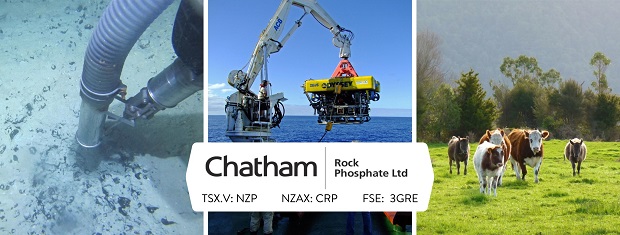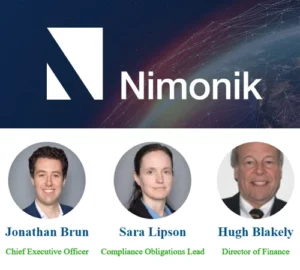
Chatham Rock Phosphate Limited (TSXV: “NZP” and NZX: “Chatham” or the “Company”) applauds the critical minerals related initiative announced this week by New Zealand Petroleum & Minerals (NZPaM) a division of the Ministry for Business, Innovation and Employment.
A discussion document that will form the first stage of developing a New Zealand critical minerals list essential for most modern technology, is likely to be released for public consultation before the end of the year.
The consultation aims to create a better understanding of the benefits of a critical minerals list for New Zealand, creating a consensus on if a mineral is critical, scoping the minerals to be considered.
In 2018, the then Minister of Energy and Resources. Hon Dr Megan Woods, stated investigation of REE recovery, was a strategic priority of the New Zealand Government and it’s encouraging to see this framework for its establishment.
This local initiative mirrors similar developments in Australia where rare earths are now being classified as Critical Minerals and critical minerals agreements are being executed with other nations.
The USA is legislating to use non-China REE in defence material and Japanese interests are signing an agreement for exploration and joint development in Queensland.
The Queensland Government’s Resources Industry Development Plan’s New Economy Minerals, (NEM) includes selenium.
Chatham consequently applied for an exploration area in western Queensland identified as having significant accumulations of selenium.
On the Chatham Rise the Company’s 820 km2 granted Mining Permit contains significant quantities of rare earth elements (REE) and other strategically valuable minerals. As reported in 2018 we established a separate corporate entity (Pacific Rare Earths Limited – PRE) to develop the extraction technology to monetise these valuable resources.
All Chatham REE activities in New Zealand and Australia are now taking place under through PRE, including the scoping study for concentration of Total Rare Earth Oxides (TREO) from our Queensland Korella phosphate areas.
Three Rare Earth Oxides, yttrium, neodymium, and dysprosium, described as critical minerals and Heavy Rare Earth Elements, are found in abundance at Korella as well as Chatham Rise.
The Australia based rare earths and selenium projects are truly nation-building initiatives where Chatham intends to play a leading part.
It now looks like the New Zealand Ministry for Business, Innovation and Employment in is very much on the same wavelength as its Australian counterparts and Chatham, with Critical Minerals projects in both countries, is uniquely positioned to bring the same benefits to the New Zealand economy.
Our REE Resources – Australia
- According to an independent report filed with the ASX in 2009, Korella Mine has an inferred yttrium JORC resource of 4.2 million tonnes at 746 g Y/tonne (i.e., 0.96 kg Y2O3/t)
- Neodymium and dysprosium were also identified at that time in both overlying sediments and the phosphate.
- Recent portable XRF analyses has shown the pervasiveness of both yttrium and neodymium in the Korella phosphate.
- Analysis of Korella phosphate samples has confirmed the presence of dysprosium and anomalous concentrations of gadolinium and samarium.
- Korella phosphate is the major host of the HREE.
We will be progressively expanding the current sampling and testing program for Korella and Korella South to quantify resources, including the overlying duricrust and regolith.

Our REE Resources – New Zealand
Rare Earths in phosphate
A study of marine phosphate nodules by the United States Geological Survey reveals significant quantities of REE within the phosphate nodules on the Chatham Rise. Of the 17 recognised rare earths, 15 are present in Chatham Rise rock phosphate nodules, as well as other valuable minerals including nickel, cobalt, chromium, vanadium, zirconium, fluorine and strontium. Collectively these minerals, if they can be efficiently extracted, represent an immensely strategic asset for New Zealand and could significantly improve the already attractive forecast project economics based on sale of phosphate.
The contained value may be released onshore (if extraction proves feasible and economically viable) without any change to the proposed mining system, and any additional environmental impacts in the Project area.
Rare Earths in Seafloor Muds
We have also previously confirmed significant rare earths and other valuable minerals in the seafloor muds in our permit area, including cerium, lanthanum, neodymium, praseodymium, yttrium, cobalt, rubidium, cesium, germanium, gallium, strontium, thallium and tungsten.
The primary challenge is the extraction process, and the processing technology required to viably separate these minerals. In addition, recovering rare earths from muds will involve a new marine mining system, and therefore will be separate from the existing CRP rock phosphate nodules project.
Further Independent Research
The information CRP already holds about REEs and other valuable minerals in its permit areas was generated by independent organisations, with some of this work undertaken a decade ago.
The current knowledge confirms that REEs occur over a wide area and estimates of the size of the potential deposits while conceptual, are potentially significant.
As a result of the extremely favourable preliminary research, CRP continues to develop a deeper understanding of the extraction and recovery potential of the minerals.
Biomining of Rare Earth Elements
Earlier this month CRP advised research progress regarding extraction of rare earth elements from phosphate minerals by Pacific Rare Earths.
Chatham’s Australian company, Avenir Makatea Pty Ltd commissioned the CSIRO work program.
Following encouraging results from stage 1 of culturing microbes potentially suitable for biomining, CSIRO will do more testing as part of an overall program to evaluate bioleaching to extract rare earth elements.
The first step was the enrichment of natural microbes in three geologic horizons within Korella, Korella North and Korella South sites in NW Queensland.
Under controlled lab conditions, the native microbes were cultured and have demonstrated three orders of magnitude cell growth (i.e., from 106-107 to 109-1010 cells per mL) over four days.
Additional subculturing of the cultures further enriched native microbes.
Subject to continued success for the balance of the preparatory phase, CRP will commit to longer duration bioleaching tests.
REE Processing and Enrichment Technology Advance
PRE recently engaged a third party to undertake sensor-based ore sorting of Korella phosphate testing to most effectively aid in REE enrichment.
Initial testing of a 75kg sample of overlying silicious sediments and phosphate showed sensor-based (density criteria) ore sorting was highly effective in separating phosphate from waste.
A one tonne sample of phosphate sent for pilot plant testing has shown particularly positive results.
Chatham engaged TOMRA Sorting to establish if their sensor-based sorting systems were capable of sorting Korella phosphate ore from waste material to improve the already relatively high-grade direct shipping ore.
The test work demonstrated Korella phosphate could be upgraded from a nominal feed of 30% P₂O₅ to a product in the range of 35% to 38% P₂O₅ at acceptable recovery rates.
Korella’s low cadmium phosphate in the range of 35% to 38% P₂O₅ is higher grade than most internationally traded rock phosphate (which is presently quoted at $US 320/t ex Casablanca) and is particularly suitable for use by European fertilizer producers which previously depended on Russian supplies of high-quality phosphate.
In addition, work is now underway to characterise the high silica waste rock from the ore sorting to establish its suitability as a source of plant available silica and as a feed stock to produce yellow phosphorus.
Marketing
The PRE target markets involve the sale of TREO with 50% heavy rare earths content to emerging Australian processors and potentially to Japan, South Korea, USA , Europe and/or Scandinavia.
About Rare Earth Elements
Yttrium, neodymium, and dysprosium are the three critical minerals described as Heavy Rare Earth Elements.
They are integral to technology including magnets, computer hard drives, wind turbines, electric vehicles, lasers, TV and computer screens, exotic light sources and superconductors.
Recent market prices of these rare earth elements are (Source: Institut fur Seltene und Metalle AG):
- Yttrium oxide US$ 12.28 per kilo.
- Dysprosium oxide US$ 366.61 per kilo.
- Neodymium oxide US$ 129.54 per kilo.
- Gadolinium oxide US$ 66.48 per kilo.
- Samarium oxide US$ 3.71 per kilo.
Written by:
Chris Castle
President and Chief Executive Officer at Chatham Rock Phosphate Limited
64 21 55 81 85 or chris@crpl.co.nz






